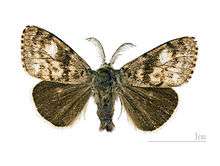Gynaephora
| Gynaephora | |
|---|---|
 | |
| Gynaephora selenitica | |
| Scientific classification | |
| Kingdom: | Animalia |
| Phylum: | Arthropoda |
| Class: | Insecta |
| Order: | Lepidoptera |
| Superfamily: | Noctuoidea |
| Family: | Erebidae |
| Tribe: | Orgyiini |
| Genus: | Gynaephora Hübner, 1819 |
Gynaephora is a genus of tussock moths in the Erebidae family. They are mainly found in the Arctic and Subarctic region and are best known for their unusually long larval development period. The lifecycle of G. groenlandica was once believed to take 14 years, but subsequent studies reduced it to 7, a slow development rate that is extremely rare in the Lepidoptera. The caterpillars have five instars, with each instar lasting a year.[1]
Species
- Gynaephora selenitica (Esper, 1789)
- Gynaephora rossii (Curtis, 1835)
- Gynaephora groenlandica (Wocke, 1874)
- Gynaephora pumila (Staudinger, 1881)
References
- ↑ Morewood, W. Dean & Richard A. Ring (1998). "Revision of the life history of the High Arctic moth Gynaephora groenlandica (Wocke) (Lepidoptera: Lymantriidae)". Can. J. Zool. 76 (7): 1371–1381. doi:10.1139/cjz-76-7-1371.
External links
- Gynaephora at The Global Lepidoptera Names Index, Natural History Museum

- Gynaephora at Butterflies and Moths of the World, Natural History Museum

- http://www.arcticCaterpillars.org
- http://www.bbc.co.uk/expeditions/ellesmereisland/stories/woollybearcaterpillar
- http://www.tolga-ltd.com
This article is issued from Wikipedia - version of the 11/19/2016. The text is available under the Creative Commons Attribution/Share Alike but additional terms may apply for the media files.